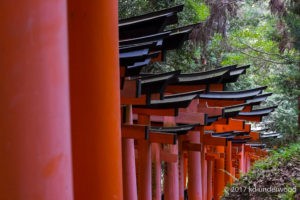 An awe-inspiring place of beauty, it was hard to image the Fushimi Inari before we arrived. Catching the first train from Kyoto Station we were among the earliest to visit the shrine. Hiking the paths through the almost continuous vermillion Torii Gates to the mountain top was an invigorating, interesting and beautiful experience. Along the way were side paths to miniature shrines and graveyards for private worship and prayer. These shrines were adorned with wooden Ema and small fox statues left in tribute and in memory.
An awe-inspiring place of beauty, it was hard to image the Fushimi Inari before we arrived. Catching the first train from Kyoto Station we were among the earliest to visit the shrine. Hiking the paths through the almost continuous vermillion Torii Gates to the mountain top was an invigorating, interesting and beautiful experience. Along the way were side paths to miniature shrines and graveyards for private worship and prayer. These shrines were adorned with wooden Ema and small fox statues left in tribute and in memory.
Dating back to the year 711, Inari is the Shinto god of rice and sake. As the role of agriculture diminished, deities were enlisted to ensure prosperity in business. The fox, or kitsune, prevalent in statue form, is the messenger of the god Inari and is often depicted with a jewel or the keys to the rice granary in its mouth. The over 10,000 Torii Gates have been donated by Japanese businesses over the last 10-centuries.
One of Japan’s most visited shrines, it is a once in a lifetime visit.
All images were taken with Fuji X100s with 23mm f2.0 lens in RAW format;; processed in Adobe Lightroom 5.7